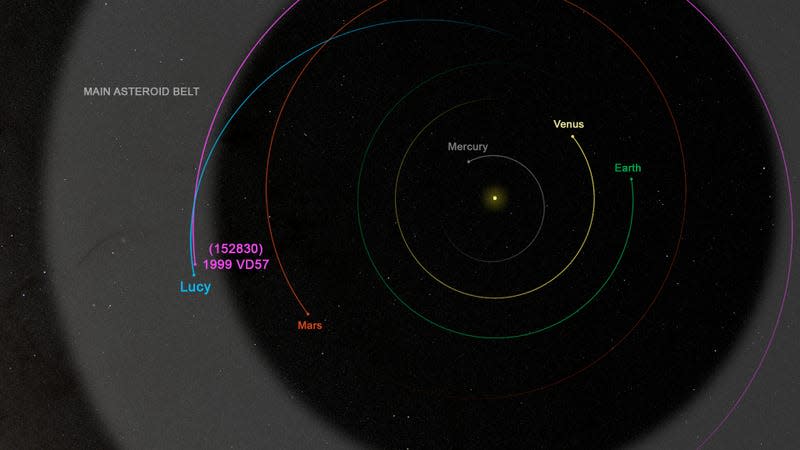NASA's Lucy Probe to Visit Bonus Asteroid This Year

There’s been a slight change to Lucy’s already-impressive itinerary. The NASA spacecraft, currently en route to visit Jupiter’s mysterious Trojan asteroids, will fly past a tiny main belt asteroid in order to test an innovative tracking system.
The target asteroid, designated (152830) 1999 VD57, is located within the asteroid belt between Mars and Jupiter. Measuring just 0.4 miles (700 meters) across, it’ll be the smallest main belt asteroid ever visited by a spacecraft, according to a NASA statement. Lucy will zip past 1999 VD57 on November 1, coming to within 280 miles (450 kilometers) of the object.
Read more
These Winning Close-Up Photos Show Life That's Often Overlooked
Remembering Enterprise: The Test Shuttle That Never Flew to Space
It’s unlikely that we’ll get detailed views of the asteroid’s surface given the distance involved, but that’s not the point of the added agenda item. The mission team wants to use the opportunity, which only presented itself after Lucy’s launch in October 2021, to test the spacecraft’s advanced asteroid-tracking capabilities.
Lucy’s ultimate goal is to reach Jupiter’s Trojan asteroids, which have never been studied up-close. The Trojans are located along Jupiter’s orbit and are organized in clumps that travel both ahead of and behind the gas giant. The Trojans are extremely old, having formed more than 4 billion years ago, making them ideal targets for investigations into the early solar system and the constituent materials that formed the planets.
Lucy is expected to travel over 4 billion miles (6.4 billion kilometers) during its mission, during which the probe will visit 10 asteroids, including 1999 VD57. The original plan was for Lucy to first visit main belt asteroid 52246 Donaldjohanson in 2025; that will still happen, but with the bonus visit now added to mission scope.
A series of small maneuvers will be required for Lucy to get reasonably close to the asteroid, the first of which is scheduled for May. Without these trajectory corrections, Lucy would get no closer than 40,000 miles (64,000 km) of 1999 VD57, as Raphael Marschall, a Lucy team member working at the Nice Observatory in France, explained in the statement. Marschall gets credit for identifying the asteroid as an ideal target for Lucy.
“I selected 500,000 asteroids with well-defined orbits to see if Lucy might be traveling close enough to get a good look at any of them, even from a distance,” he said. “This asteroid really stood out.”
The brief visit will allow for an engineering test of Lucy’s tracking system. A longstanding challenge of flyby missions is that, as probes approach their target, they struggle to determine the exact distances involved, which in turn makes it difficult for them to accurately point cameras at the subject. The traditional solution to this problem is rather inelegant: snap as many images as possible in the general direction of the target in hopes of acquiring some valuable shots.
This is obviously wasteful and results in “lots of images of blank space,” Hal Levison, Lucy principal investigator from the Southwest Research Institute Boulder, said in the statement. “Lucy will be the first flyby mission to employ this innovative and complex system to automatically track the asteroid during the encounter,” he added. “This novel system will allow the team to take many more images of the target.”
This will mark the first in-space test of the system, but 1999 VD57 is expected to be ideal for this test in that Lucy’s approach angle relative to the Sun will be akin to its approach angles when approaching the Trojans. Accordingly, NASA is referring to Lucy’s flyby of 1999 VD57 as a “dress rehearsal” for the spacecraft’s primary mission at Jupiter’s Trojans.
Lucy is functioning properly despite one of its two 24-foot-wide (7-meter) power-supplying solar arrays not fully deploying after launch. The circular panel is mostly open, but it’s stuck in an unlatched position. Mission controllers made repeated attempts to fully deploy the array, but mission managers recently decided to suspend potential fixes, saying Lucy is too cold. The team may try again in 2024 when the spacecraft performs a gravity assist near Earth.
More: This Is Fine: NASA Pauses Attempts to Fix Lucy’s Pesky Solar Array
More from Gizmodo
Sign up for Gizmodo's Newsletter. For the latest news, Facebook, Twitter and Instagram.

